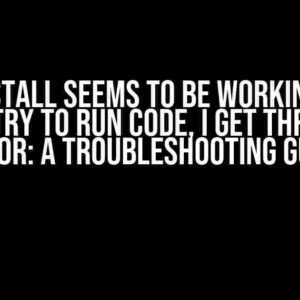Have you ever encountered the frustrating error message “ConnectEx: A connection attempt failed because the connected party did not properly respond after a period of time”? If so, you’re not alone! This error can be a major roadblock for developers, sysadmins, and users alike. But fear not, dear reader, for we’re about to delve into the world of ConnectEx and explore the causes, solutions, and preventive measures to ensure this error becomes a thing of the past.
What is ConnectEx?
ConnectEx is a Windows API function that allows an application to establish a connection to a remote host. It’s an extension of the traditional Connect function, providing additional features and improvements for network communication. When a connection attempt fails using ConnectEx, the aforementioned error message is often displayed.
Causes of the “ConnectEx: A Connection Attempt Failed” Error
Before we dive into the solutions, let’s explore the common causes of this error:
- Network Connectivity Issues: Firewalls, routers, or switches might be blocking the connection, causing the remote host to not respond properly.
- Server Timeout: The remote server might be experiencing high latency, causing the connection attempt to timeout.
- Remote Host Unavailability: The remote host might be down, unavailable, or not configured to accept connections.
- Application Configuration: Misconfigured application settings, such as incorrect IP addresses or port numbers, can lead to connection failures.
- System Resource Issues: Insufficient system resources, like memory or CPU, can cause the connection attempt to fail.
Solutions to the “ConnectEx: A Connection Attempt Failed” Error
Now that we’ve identified the causes, let’s explore the solutions:
1. Check Network Connectivity
Verify that your network connection is stable and functioning correctly:
- Use the
pingcommand to test network connectivity to the remote host. - Check firewall settings and ensure the necessary ports are open.
- Verify that routers and switches are properly configured.
2. Adjust Server Timeout Settings
Increase the server timeout settings to allow for more time to establish a connection:
// C++ example
dwTimeout = 30000; // Set timeout to 30 seconds
connectEx(..., dwTimeout, ...);
3. Verify Remote Host Availability
Confirm that the remote host is available and configured to accept connections:
- Ping the remote host to ensure it’s reachable.
- Verify that the remote host’s application is running and configured correctly.
4. Check Application Configuration
Review and correct any misconfigured application settings:
| Setting | Verify |
|---|---|
| IP Address | Ensure the correct IP address is used. |
| Port Number | Verify that the correct port number is used. |
| Protocol | Ensure the correct protocol (e.g., TCP or UDP) is used. |
5. Optimize System Resources
Ensure that system resources are sufficient to handle the connection attempt:
- Close unnecessary applications to free up system resources.
- Consider upgrading system hardware or allocating more resources.
Preventative Measures
To avoid encountering the “ConnectEx: A Connection Attempt Failed” error in the future, follow these best practices:
- Implement Connection Retries: Use a retry mechanism to automatically reconnect in case of a failed connection attempt.
- Monitor System Resources: Regularly monitor system resources to ensure they’re sufficient for network communication.
- Regularly Test Network Connectivity: Schedule regular network connectivity tests to identify potential issues before they become major problems.
Conclusion
The “ConnectEx: A Connection Attempt Failed” error can be frustrating, but by understanding the causes and implementing the solutions outlined above, you’ll be well on your way to resolving this issue. Remember to take preventative measures to ensure a stable and reliable network connection. With this comprehensive guide, you’ll be equipped to tackle even the most stubborn ConnectEx errors.
Don’t let the “ConnectEx: A Connection Attempt Failed” error hold you back any longer. Take control of your network connections and ensure smooth communication with the remote host. Happy troubleshooting!
Frequently Asked Question
Still stuck on the infamous “connectex” error? Worry not, we’ve got you covered! Here are some frequently asked questions and answers to help you troubleshoot the issue:
What does the “connectex” error mean?
The “connectex” error typically occurs when a connection attempt fails due to the connected party not responding within a specified time frame. This can be caused by a variety of factors, including network connectivity issues, server overload, or even firewall blocks.
What are some common causes of the “connectex” error?
Some common causes of the “connectex” error include incorrect network settings, ISP throttling, server downtime, and even malware or virus infections. Additionally, outdated software or plugins can also contribute to this error.
How do I troubleshoot the “connectex” error?
To troubleshoot the “connectex” error, try restarting your router and modem, checking your network settings, and disabling any firewalls or antivirus software that may be interfering with your connection. You can also attempt to connect to the server using a different network or device to isolate the issue.
Can I prevent the “connectex” error from happening?
While the “connectex” error can’t be completely prevented, you can take steps to reduce its occurrence. Regularly update your software and plugins, ensure your network settings are correct, and consider using a VPN to bypass ISP throttling.
What if I’m still experiencing issues after troubleshooting?
If you’ve tried troubleshooting and are still experiencing issues, it may be best to contact your ISP or server administrator for further assistance. They can help diagnose the problem and provide more targeted solutions.



